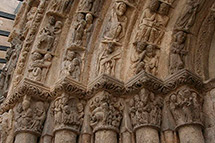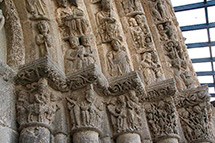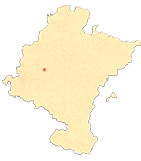La Portada de San Miguel de Estella
Capitals
The ten capitals read from left to right. The first presents Gabriel's Annunciation to Mary: the archangel bends his knee and raises his hand slightly towards Mary, sitting demurely, behind whom we see a rather heavy-headed old Joseph, asleep holding his staff. The second capital is divided into two scenes: the first, Mary's embrace of her cousin Elizabeth, i.e. the Visitation; the second, sample , shows Mary in bed, surrounded by Joseph and a midwife, under a curtained arch. The Nativity scene is completed on the outer face of the third capital, where the infant Jesus, lying in the manger, is breathed on by the mule and the ox, while an angel flies over the scene towards the figures on the other face. Here we find the angel's advertisement two shepherds, one with a fur hood and fur hood, the other with a staff and bag, accompanied by their livestock. The fourth capital focuses on the Adoration of the Magi, identified by their actions and crowns. The first, bearded, opens the lid of a cup before the infant Jesus seated on his mother's knee. The eight-pointed star can be seen between the head of the king and that of Mary. Behind the child, Joseph sleeps, holding his long staff. The other two kings are in dialogue, waiting their turn with luxurious goblets in their hands. The fifth capital is dedicated to the presentation of the child in the temple: Joseph carries him in his arms, Mary follows him with turtledoves in her hands; before them stand the prophetess Anna, who touches Jesus' foot, and, turned towards the altar, the old man Simeon.
On the other side of the door, the sixth capital summarises the Flight into Egypt in two scenes: Joseph's dream, with the little angel touching his head, and the journey of Mary and the Child on the back of a donkey, whose reins Joseph grasps while holding with his left hand the pole of the bundle on his shoulder. In the seventh capital Herod occupies the corner, accompanied by a soldier with a blocked shield. Sceptre in hand, he addresses two bearded figures pointing to something in a book: they are the wise men who inform the king of the place where the Messiah is to be born. The eighth deals with the slaughter of the innocents: the mothers cannot contain their horror at the soldiers who slit the throats of their children or snatch them away, despite their efforts to protect them. Several children's corpses lie at their feet. In the ninth and tenth, young fighters with spears, swords and bows, trapped in a tangle of vegetation, attack dragons that bite their legs. Both have been seen as allegorical representations of the struggle between good and evil, or the defence of man against the evil lurking in life.












